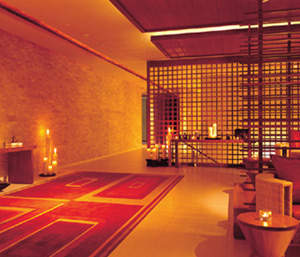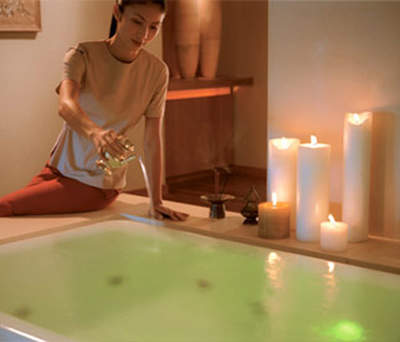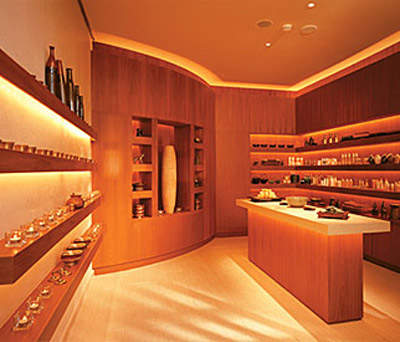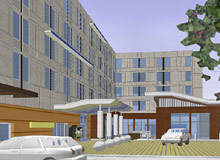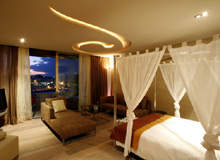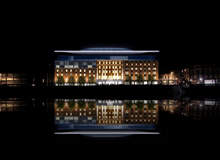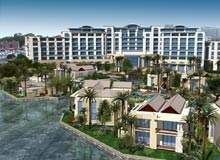In February 2006, construction began on the Marunouchi Trust Tower Main Building, the second building in the Marunouchi Trust Tower project that was developed on a site adjacent to Tokyo Station.
The skyscraper complex includes offices, a five-star luxury hotel and commercial facilities. The hotel serves as a suitable face for Japan’s capital city, supporting international business and tourism.
Construction began in February 2006 and was completed in November 2008. Marunouchi Trust Tower Main Building is located on a 12,026.77m² site at Marunouchi, Chiyoda-ku in Tokyo. The total floor area for the new main building, which is used for offices, the hotel, a tourist information centre and a retail complex, is 116,000m². The hotel has 37 floors above ground and four below ground in the new building, which was developed by Mori Trust.
The complex of buildings, including the hotel, is said to be worth $3.5bn (over ¥21bn), in an area of Tokyo where real estate has one of the highest values anywhere in the world at $200,000 per square metre.
Shangri-La background details
Shangri-La International Hotel Management signed a lease agreement with Mori Trust in September 2006 to fit out and manage the Shangri-La Hotel, Tokyo. This is the group’s first Japanese hotel, which opened in March 2009. The hotel is located in the Marunouchi district adjacent to Tokyo Station. The Imperial Palace and the Nihonbashi area are a ten minute walk away, making the site convenient for tourists.
The Shangri-La Hotel occupies the top 11 floors of the 37-storey Marunouchi Trust Tower’s main building, while the lower floors house offices and retail shops. The hotel’s 204 guestrooms average 50m² in size and has 24 suites – 20 junior suites, three executive suites and one presidential suite on the top floor. Meeting and banquet space includes 400m² of grand ballroom and function areas as well as a chapel for weddings, vow renewals and blessing ceremonies.
The hotel also houses two complete floors of exclusive Horizon club accommodation, including a Horizon club lounge. The health club features a gymnasium as well as a heated swimming pool located indoors, offering a complete view of the city.
Dining facilities
Shangri-La Hotel, Tokyo, provides an array of dining experiences, including an all-day restaurant featuring a glass ceiling on the 28th floor and a speciality restaurant on the 29th floor. Guests arrive from the ground floor in dedicated hotel lifts and are greeted at the 28th floor lobby by dramatic views overlooking the Marunouchi area with Tokyo Bay to the East, through a backdrop of 26ft high, floor-to-ceiling windows. Similar cityscapes are enjoyed by guests relaxing with refreshments in the lobby lounge.
Giovanni Angelini, CEO and MD of Shangri-La Hotels and Resorts, said: “The Shangri-La Hotel, Tokyo plays a key role in our group’s international expansion. Shangri-La properties have long been favourites of many Japanese business and leisure travellers. We are grateful that, with the support of Mori Trust, we are able to introduce our Shangri-La style of hospitality to Japan and provide a new, exciting luxury hotel experience for our loyal guests,
wherever they are.”
CHI, The spa at Shangri-La
Shangri-La’s own spa brand, CHI, The Spa at Shangri-La, made its Japanese debut at Shangri-La Hotel, Tokyo. Designed to create a sanctuary of tranquility inspired by the legend of Shangri-La, CHI introduced the concept of treatments based on ancient Chinese and Himalayan healing therapies.
The free flow of chi within the body is essential to the maintenance of good health. The treatment suites of CHI spas offer a ‘spa within a spa’ concept, providing each guest with their own changing, shower and toilet areas, in addition to heat treatments, bathing and relaxation spaces.
Developed by a team of experts, CHI’s signature therapies are based on the Five Elements Theory, in which metal, water, wood, fire and earth are in balance to harmonise with the positive yang and negative yin energy within the body.
Shangri-La construction
The building was constructed by TODA Construction of Japan,the main construction contractor. Kajima Corporation was involved in the construction of the new building with KPMG Japan performing a project management role in the complex.
The architects are Mitsui Fudosan, Hopkins Architects and Yasui Architects & Engineers. Other companies involved in the construction include Mitsui Fudosan and Takenaka Corporation Tokyo.


